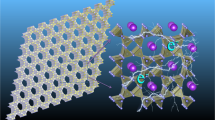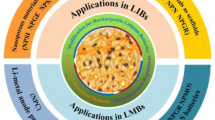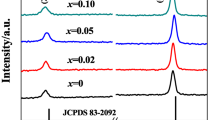Abstract
The cycling performance of high-capacity lithium ion battery anodes can be significantly improved by adopting 3D nanoporous structures that can efficiently accommodate large volume changes during lithiation and de-lithiation. In this study, various molybdenum oxide nanoporous asymmetric membranes were fabricated on a large scale via a spontaneous non-solvent-induced phase separation process. We explored the effects of polymer precursor, membrane geometry, and annealing condition on the porosity, composition, and electrochemical properties of the membranes as lithium ion battery anodes. We demonstrate that 97% initial capacity of MoO2 planar asymmetric membrane electrode can be retained in 165 cycles at 120 mA g−1. 74% initial capacity can be maintained while the current density is increased from 60 to 480 mA g−1. This efficient and scalable process to prepare molybdenum oxide-based LIB anode provides another alternative to enhance the electrochemical performance of transition metal oxide anodes at a relatively low fabrication cost.
Graphic abstract








Similar content being viewed by others
Availability of data and material
The datasets generated during and/or analyzed during the current study are available from the corresponding author on reasonable request.
Change history
26 October 2021
A Correction to this paper has been published: https://doi.org/10.1557/s43578-021-00414-z
References
M. Yu, H. Shao, G. Wang, F. Yang, C. Liang, P. Rozier, C.-Z. Wang, X. Lu, P. Simon, X. Feng, Interlayer gap widened α-phase molybdenum trioxide as high-rate anodes for dual-ion-intercalation energy storage devices. Nat. Commun. 11(1), 1348 (2020)
W.-J. Li, Z.-W. Fu, Nanostructured WO3 thin film as a new anode material for lithium-ion batteries. Appl. Surf. Sci. 256(8), 2447 (2010)
R. Bekarevich, Y. Pihosh, Y. Tanaka, K. Nishikawa, Y. Matsushita, T. Hiroto, H. Ohata, T. Ohno, T. Minegishi, M. Sugiyama, T. Kitamori, K. Mitsuishi, K. Takada, Conversion reaction in the binder-free anode for fast-charging Li-ion batteries based on WO3 nanorods. ACS Appl. Energy Mater. 3(7), 6700 (2020)
Y. Liu, Y. Jiao, H. Zhou, X. Yu, F. Qu, X. Wu, Rational design of WO(3) nanostructures as the anode materials for lithium-ion batteries with enhanced electrochemical performance. Nanomicro Lett. 7(1), 12 (2015)
Y. Wang, Z. Huang, Y. Wang, A new approach to synthesize MoO2@C for high-rate lithium ion batteries. J. Mater. Chem. A 3(42), 21314 (2015)
S. Petnikota, K.W. Teo, L. Chen, A. Sim, S.K. Marka, M.V. Reddy, V.V.S.S. Srikanth, S. Adams, B.V.R. Chowdari, Exfoliated graphene oxide/MoO2 composites as anode materials in lithium-ion batteries: an insight into intercalation of Li and conversion mechanism of MoO2. ACS Appl. Mater. Interfaces 8(17), 10884 (2016)
S. Fang, D. Bresser, S. Passerini, Transition metal oxide anodes for electrochemical energy storage in lithium- and sodium-ion batteries. Adv. Energy Mater. 10(1), 1902485 (2020)
Y. Chen, X. Chen, Y. Zhang, A comprehensive review on metal-oxide nanocomposites for high-performance lithium-ion battery anodes. Energy Fuels 35(8), 6420 (2021)
A. Manthiram, A reflection on lithium-ion battery cathode chemistry. Nat. Commun. 11(1), 1550 (2020)
L. Zhou, L. Yang, P. Yuan, J. Zou, Y. Wu, C. Yu, α-MoO3 nanobelts: a high performance cathode material for lithium ion batteries. J. Phys. Chem. C. 114(49), 21868 (2010)
X. Zhao, W. Jia, X. Wu, Y. Lv, J. Qiu, J. Guo, X. Wang, D. Jia, J. Yan, D. Wu, Ultrafine MoO3 anchored in coal-based carbon nanofibers as anode for advanced lithium-ion batteries. Carbon 156, 445 (2020)
U.K. Sen, S. Mitra, Synthesis of molybdenum oxides and their electrochemical properties against Li. Energy Procedia. 54, 740 (2014)
M.A. Camacho-López, L. Escobar-Alarcón, M. Picquart, R. Arroyo, G. Córdoba, E. Haro-Poniatowski, Micro-Raman study of the m-MoO2 to α-MoO3 transformation induced by cw-laser irradiation. Opt. Mater. 33(3), 480 (2011)
R.J. Petersen, Composite reverse osmosis and nanofiltration membranes. J. Membr. Sci. 83(1), 81 (1993)
J. Radjenović, M. Petrović, F. Ventura, D. Barceló, Rejection of pharmaceuticals in nanofiltration and reverse osmosis membrane drinking water treatment. Water Res. 42(14), 3601 (2008)
B. Nicolaisen, Developments in membrane technology for water treatment. Desalination 153(1), 355 (2003)
J. Wu, H. Chen, C. Padgett, Silicon asymmetric membranes for efficient lithium storage: a scalable method. Energy Technol. 4(4), 502 (2016)
I. Byrd, H. Chen, T. Webber, J. Li, J. Wu, Self-assembled asymmetric membrane containing micron-size germanium for high capacity lithium ion batteries. RSC Adv. 5(113), 92878 (2015)
J. Wu, H. Chen, I. Byrd, S. Lovelace, C. Jin, Fabrication of SnO2 asymmetric membranes for high performance lithium battery anode. ACS Appl. Mater. Interfaces 8(22), 13946 (2016)
M. Li, C. Anderson, P. Beaupre, C. Jin, J. Li, J. Wu, Tin asymmetric membranes for high capacity sodium ion battery anodes. Mater. Today Commun. 24, 100998 (2020)
M. Müller, V. Abetz, Nonequilibrium processes in polymer membrane formation: theory and experiment. Chem. Rev. (2021). https://doi.org/10.1021/acs.chemrev.1c00029
G.M. Geise, H.B. Park, A.C. Sagle, B.D. Freeman, J.E. McGrath, Water permeability and water/salt selectivity tradeoff in polymers for desalination. J. Membr. Sci. 369(1), 130 (2011)
J. Wienold, R.E. Jentoft, T. Ressler, Structural investigation of the thermal decomposition of ammonium heptamolybdate by in situ XAFS and XRD. Eur. J. Inorg. Chem. 2003(6), 1058 (2003)
M. Ihsan, H. Wang, S.R. Majid, J. Yang, S.J. Kennedy, Z. Guo, H.K. Liu, MoO2/Mo2C/C spheres as anode materials for lithium ion batteries. Carbon 96, 1200 (2016)
J.C. Lee, B.H. Lee, B.G. Kim, M.J. Park, D.Y. Lee, I.H. Kuk, H. Chung, H.S. Kang, H.S. Lee, D.H. Ahn, The effect of carbonization temperature of PAN fiber on the properties of activated carbon fiber composites. Carbon 35(10), 1479 (1997)
I. Pinnau, W.J. Koros, Structures and gas separation properties of asymmetric polysulfone membranes made by dry, wet, and dry/wet phase inversion. J. Appl. Polym. Sci. 43(8), 1491 (1991)
I.-C. Kim, H.-G. Yun, K.-H. Lee, Preparation of asymmetric polyacrylonitrile membrane with small pore size by phase inversion and post-treatment process. J. Membr. Sci. 199(1), 75 (2002)
K.-W. Lee, B.-K. Seo, S.-T. Nam, M.-J. Han, Trade-off between thermodynamic enhancement and kinetic hindrance during phase inversion in the preparation of polysulfone membranes. Desalination 159(3), 289 (2003)
C. Barth, M.C. Gonçalves, A.T.N. Pires, J. Roeder, B.A. Wolf, Asymmetric polysulfone and polyethersulfone membranes: effects of thermodynamic conditions during formation on their performance. J. Membr. Sci. 169(2), 287 (2000)
J. Zhang, T. Wang, P. Liu, Z. Liao, S. Liu, X. Zhuang, M. Chen, E. Zschech, X. Feng, Efficient hydrogen production on MoNi4 electrocatalysts with fast water dissociation kinetics. Nat. Commun. 8(1), 15437 (2017)
R.K. Sharma, G.B. Reddy, Synthesis and characterization of α-MoO3 microspheres packed with nanoflakes. J. Phys. D: Appl. Phys. 47(6), 065305 (2014)
M. Tang, A.T. Nelson, E.S. Wood, S.A. Maloy, Y.-B. Jiang, Grazing incidence X-ray diffraction and transmission electron microscopy studies on the oxide formation of molybdenum in a water vapor environment. Scr. Mater. 120, 49 (2016)
X. Lu, R. Wang, F. Yang, W. Jiao, W. Liu, L. Hao, X. He, Preparation of MoO3 QDs through combining intercalation and thermal exfoliation. J. Mater. Chem. C. 4(28), 6720 (2016)
H. Sitepu, B.H. O’Connor, D. Li, Comparative evaluation of the March and generalized spherical harmonic preferred orientation models using X-ray diffraction data for molybdite and calcite powders. J. Appl. Crystallogr. 38(1), 158 (2005)
D.E. Cox, R.J. Cava, D.B. McWhan, D.W. Murphy, A neutron powder diffraction study of the lithium insertion compound LiMoO2 from 4–440K. J. Phys. Chem. Solids 43(8), 657 (1982)
E. Pu, D. Liu, P. Ren, W. Zhou, D. Tang, B. Xiang, Y. Wang, J. Miao, Ultrathin MoO2 nanosheets with good thermal stability and high conductivity. AIP Adv. 7(2), 025015 (2017)
C.F. Holder, R.E. Schaak, Tutorial on powder X-ray diffraction for characterizing nanoscale materials. ACS Nano 13(7), 7359 (2019)
D.O. Scanlon, G.W. Watson, D.J. Payne, G.R. Atkinson, R.G. Egdell, D.S.L. Law, Theoretical and experimental study of the electronic structures of MoO3 and MoO2. J. Phys. Chem. C 114(10), 4636 (2010)
J. Baltrusaitis, B. Mendoza-Sanchez, V. Fernandez, R. Veenstra, N. Dukstiene, A. Roberts, N. Fairley, Generalized molybdenum oxide surface chemical state XPS determination via informed amorphous sample model. Appl. Surf. Sci. 326, 151 (2015)
F. Borgatti, J.A. Berger, D. Céolin, J.S. Zhou, J.J. Kas, M. Guzzo, C.F. McConville, F. Offi, G. Panaccione, A. Regoutz, D.J. Payne, J.-P. Rueff, O. Bierwagen, M.E. White, J.S. Speck, M. Gatti, R.G. Egdell, Revisiting the origin of satellites in core-level photoemission of transparent conducting oxides: the case of n-doped SnO2. Phys. Rev. B. 97(15), 155102 (2018)
L. Fransson, T. Eriksson, K. Edström, T. Gustafsson, J.O. Thomas, Influence of carbon black and binder on Li-ion batteries. J. Power Sources 101(1), 1 (2001)
Q. Ai, D. Li, J. Guo, G. Hou, Q. Sun, Q. Sun, X. Xu, W. Zhai, L. Zhang, J. Feng, P. Si, J. Lou, L. Ci, Artificial solid electrolyte interphase coating to reduce lithium trapping in silicon anode for high performance lithium-ion batteries. Adv. Mater. Interfaces 6(21), 1901187 (2019)
I. Byrd, J. Wu, Asymmetric membranes containing micron-size silicon for high performance lithium ion battery anode. Electrochim. Acta 213, 46 (2016)
K. Goldshtein, K. Freedman, D. Schneier, L. Burstein, V. Ezersky, E. Peled, D. Golodnitsky, Advanced multiphase silicon-based anodes for high-energy-density Li-ion batteries. J. Electrochem. Soc. 162(6), A1072 (2015)
Q.-L. Wu, S.-X. Zhao, L. Yu, L.-Q. Yu, X.-X. Zheng, G. Wei, In situ synthesis and electrochemical performance of MoO3−x nanobelts as anode materials for lithium-ion batteries. Dalton Trans. 48(34), 12832 (2019)
S. Yoon, K.-N. Jung, C.S. Jin, K.-H. Shin, Synthesis of nitrided MoO2 and its application as anode materials for lithium-ion batteries. J. Alloys Compd. 536, 179 (2012)
L. Zhong, J. Guo, L. Mangolini, A stable silicon anode based on the uniform dispersion of quantum dots in a polymer matrix. J. Power Sources 273, 638 (2015)
P. Wu, S. Chen, A. Liu, The influence of contact engineering on silicon-based anode for Li-ion batteries. Nano Select 2(3), 468 (2021)
A.R.C. Bredar, A.L. Chown, A.R. Burton, B.H. Farnum, Electrochemical impedance spectroscopy of metal oxide electrodes for energy applications. ACS Appl. Energy Mater. 3(1), 66 (2020)
C. Li, C. Liu, W. Wang, J. Bell, Z. Mutlu, K. Ahmed, R. Ye, M. Ozkan, C.S. Ozkan, Towards flexible binderless anodes: silicon/carbon fabrics via double-nozzle electrospinning. Chem. Commun. 52(76), 11398 (2016)
H.-S. Kim, J.B. Cook, S.H. Tolbert, B. Dunn, The development of pseudocapacitive properties in nanosized-MoO2. J. Electrochem. Soc. 162(5), A5083 (2015)
S. Lorger, K. Narita, R. Usiskin, J. Maier, Enhanced ion transport in Li2O and Li2S films. Chem. Commun. 57(53), 6503 (2021)
J. Wu, C. Anderson, P. Beaupre, S. Xu, C. Jin, A. Sharma, Co-axial fibrous silicon asymmetric membranes for high-capacity lithium-ion battery anode. J. Appl. Electrochem. 49(10), 1013 (2019)
M. Jing, C.-G. Wang, Q. Wang, Y.-J. Bai, B. Zhu, Chemical structure evolution and mechanism during pre-carbonization of PAN-based stabilized fiber in the temperature range of 350–600°C. Polym. Degrad. Stab. 92(9), 1737 (2007)
Acknowledgments
This work is supported by National Science Foundation Division of Chemical, Bioengineering, Environmental and Transport Systems (NSF CBET Award #1800619). XPS was performed in the Nebraska Nanoscale Facility: National Nanotechnology Coordinated Infrastructure and the Nebraska Center for Materials and Nanoscience (and/or NERCF), which are supported by the National Science Foundation under Award ECCS: 2025298, and the Nebraska Research Initiative. This research also used resources at the Center for Functional Nanomaterials at Brookhaven National Laboratory, which is a U.S. DOE Office of Science Facility under contract DE-SC0012704. J.W. and J. D. also want to acknowledge the generous infrastructural support provided by Georgia Southern University and GSU COUR award.
Funding
NSF CBET Award #1800619; NSF ECCS Award #2025298; U.S. DOE Office of Science Facility under contract DE-SC0012704.; Georgia Southern University COUR Award.
Author information
Authors and Affiliations
Contributions
E.L., L.W., C.J., and X.C. carried out the experiments and participated in scientific discussion and manuscript preparation as well. J.D., O.S., and S.X. performed the experiments. J.W. came up with the research hypothesis, designed the experiments, managed the project, and drafted the manuscript.
Corresponding author
Ethics declarations
Conflict of interest
All authors declare that they have no conflict of interest.
Additional information
This article was updated to correct Olivia Sheppard’s name.
Supplementary Information
Below is the link to the electronic supplementary material.
Rights and permissions
About this article
Cite this article
Larson, E., Williams, L., Jin, C. et al. Molybdenum oxide nanoporous asymmetric membranes for high-capacity lithium ion battery anode. Journal of Materials Research 37, 2204–2215 (2022). https://doi.org/10.1557/s43578-021-00347-7
Received:
Accepted:
Published:
Issue Date:
DOI: https://doi.org/10.1557/s43578-021-00347-7




